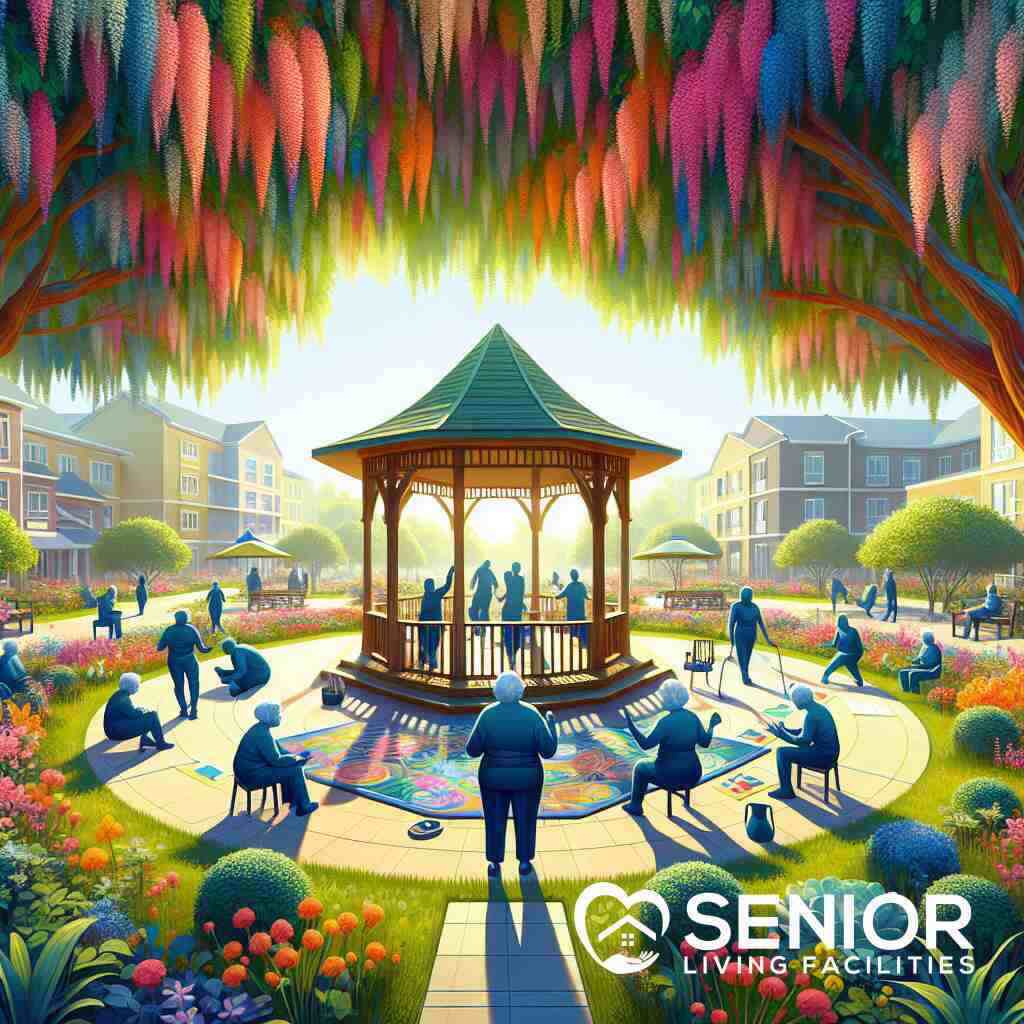
The Difference Between Assisted and Independent Living
October 12, 2024
Introduction to Senior Living Choices
Understanding Senior Housing Landscape
Navigating the complexities of senior housing involves understanding the diverse options available for older adults. These include independent living communities, assisted living facilities, and other specialized care environments. Senior living facilities offer varied accommodations catering to different needs, lifestyles, and preferences. Whether a senior prefers autonomy or needs assistance in daily activities, the landscape of senior housing provides multiple pathways. Understanding these pathways is crucial for ensuring that seniors are placed in environments where they can thrive and find satisfaction in their daily lives.
Senior Lifestyle Choices
As seniors embark on this new phase of life, lifestyle choices become pivotal in determining their living arrangements. Each senior is unique, and their preferences can greatly influence whether they choose independent or assisted living. Factors such as the need for community engagement, level of desired independence, and specific healthcare needs play significant roles. For instance, some may thrive in communities that emphasize social interaction, while others may prioritize privacy and self-reliance. By prioritizing personal lifestyle choices, seniors can effectively select housing that aligns with their aspirations and daily routines.
A New Chapter in Senior Living Communities
Entering senior living communities marks a new chapter filled with opportunities and experiences tailored to the aging population. These communities are designed to foster active living and social connection, providing seniors with a supportive environment. From vibrant activities to comprehensive health and wellness programs, these communities aim to enhance overall well-being. The focus is on creating a holistic environment where seniors not only live but thrive, embracing the support and amenities offered to them. As this new chapter unfolds, seniors and their families can take comfort in knowing that a variety of options exist to meet their evolving needs.
Delving into Independent Living
Autonomy in Independent Living
Autonomy is a defining feature of independent senior living. Many seniors prioritize maintaining their independence and adulthood responsibilities, which is why independent living communities cater to this desire. These communities provide residents with private residences, typically apartments or small homes, giving them the freedom to live as they see fit while offering communal amenities to enhance their lifestyle. Seniors in places like independent senior living in New York enjoy the flexibility of self-governance while having access to various services when desired, such as dining options and social clubs that encourage engagement without imposing restrictions.
Seniors often choose this form of living arrangement to have a strong sense of control over their environments while simplifying their living conditions. This type of living encourages active involvement in community events yet prioritizes personal space and independence. Seniors can manage their routines and engage in activities that align with their interests, crafting an individualized lifestyle. The key to thriving in these settings lies in balancing personal autonomy with the opportunity to connect with others, creating a fulfilling, independent life.
Benefits of Independent Living Communities for Seniors
The benefits of joining independent living communities are numerous, particularly in fostering a sense of belonging while maintaining self-sufficiency. These communities enable seniors to live in well-maintained environments, often offering housekeeping, transportation services, and meal plans, taking the hassle out of daily chores. Seniors benefit from an enriched lifestyle due to the wide array of recreational activities and social events that such communities present.
Living in independent communities broadens opportunities for companionship and friendship, reducing feelings of isolation that can sometimes accompany aging. The sense of community is a powerful motivator for seniors, encouraging socialization and active participation in scheduled events that match their interests. Moreover, with ongoing access to amenities such as fitness centers, pools, and libraries, seniors can lead health-conscious and mentally stimulating lives, further elevating their quality of life while enjoying the freedom of independent living.
Exploring Social Activities in Senior Communities
One pivotal aspect of independent living is the diverse array of social activities available, which fosters engagement and a vibrant community life. These activities range from cultural outings, art classes, group exercises, and hobby clubs, allowing seniors to explore interests and connect with like-minded individuals. The importance of social activities for seniors cannot be overstated, as they play a crucial role in physical health and emotional well-being.
Participating in varied social activities helps seniors form bonds, combat loneliness, and even improve cognitive functions through continuous mental stimulation. Community events provide a supportive atmosphere where seniors can share experiences, celebrate milestones, and participate in lifelong learning opportunities. As these communities continue to innovate, technology integration allows for even more personalized engagement, offering digital platforms to keep connected and informed. The Rise of Technology in Senior Living Facilities for 2024 This vibrant social tapestry reinforces an inclusive environment, ensuring that independent living continues to appeal to seniors seeking a balanced blend of freedom and community.
Assisted Living Unveiled
Comprehensive Look at Assisted Living Facility Benefits
Assisted living facilities offer a bridge between independent living and the specialized care found in nursing homes. These facilities provide a supportive environment where seniors receive necessary assistance while maintaining autonomy in daily life. Residents benefit from services that cater to both practical needs, such as meal preparation and housekeeping, and personal care, including bathing and medication management. The assisted living guide highlights these advantages, showing how such environments significantly enhance the quality of life.
Social engagement remains a central focus within assisted living facilities, fostering community and camaraderie among residents. Scheduled activities and events create opportunities for seniors to socialize and engage in various pursuits, which are crucial for emotional well-being. These facilities intentionally design communities to balance privacy with the benefits of shared experiences. Thus, seniors in assisted living enjoy a vibrant lifestyle supported by the care they need to excel daily.
Level of Care in Assisted Living Facilities
Assisted living facilities provide a tailored level of care that aligns with each resident’s individual needs. This personalized approach ensures that seniors receive the appropriate support without sacrificing their independence. Care plans often include assistance with activities of daily living for seniors, such as mobility, personal hygiene, and medication management, adapting to changes in health conditions over time.
The caregiving team in assisted living facilities is trained to assist with daily tasks while encouraging residents to participate fully in their routines. This commitment to personalized care fosters an environment in which seniors can thrive despite the challenges of aging. Families find peace of mind knowing their loved ones are receiving care tailored to their unique requirements, ensuring both safety and satisfaction.
The Integration of Medical Care in Senior Homes
Integration of medical care is a vital component of the assisted living model, addressing both preventative and ongoing health needs. Facilities work closely with healthcare providers to offer regular health assessments, coordinating care to ensure residents receive consistent and comprehensive attention. This approach minimizes hospital visits and maintains residents’ well-being through proactive health management measures. The relevance of health care in senior homes is evident as it enhances longevity and improves daily life.
Assisted living facilities often incorporate pharmacy services and provide access to specialists as needed. Some communities might even feature on-site healthcare services, offering routine check-ups and emergency care. By offering integrated medical services, assisted living communities support seniors in managing chronic conditions, thereby promoting overall health stability. This strategic blend of care and independence solidifies the role of these facilities as a truly viable option for enhancing the quality of life for seniors.
Comparative Analysis: Independent vs. Assisted Living
Senior Independence vs. Assistance
Choosing between a senior independence lifestyle and one that involves assistance revolves around balancing autonomy and support. In independent living communities for seniors, the focus is on maintaining freedom while providing a secure and engaging environment. Residents manage their daily routines, enjoying vibrant community amenities at their own pace. Conversely, assisted living facilities emphasize personalized care, ensuring seniors receive support in activities of daily living. The difference between these senior living facilities lies in the level of assistance provided, whereas assisted living offers targeted support without compromising personal dignity.
Seniors who lean towards independence may thrive in environments where self-sufficiency is nurtured, providing a sense of accomplishment. However, for those who benefit from assistance due to health challenges or mobility issues, assisted living ensures their needs are met. Understanding the nuances between these options is crucial as seniors and families decide the best pathway for care and lifestyle. Each setting offers a distinct experience, aligning with the varying needs and preferences of the senior population.
Cost of Assisted Living vs. Independent Living
Financial considerations play a significant role in selecting between assisted living and independent living communities. Independent living generally incurs lower costs since residents primarily fund housing and optional services, which can vary based on location and facilities offered. For example, exploring senior communities in Florida may reveal cost-effective options due to varying state regulations and living costs.
Assisted living, meanwhile, involves more comprehensive care services, which typically results in higher fees. These costs can encompass medical care, personal assistance, and inclusive amenities, providing a holistic approach to elderly care. Choosing a senior living facility becomes a financial balancing act, factoring in both budget constraints and the desired level of care. Review of Affordable Housing Options for Seniors in Texas Evaluating financial implications alongside care needs ensures seniors receive adequate support without unexpected financial strains.
Comparing Senior Living Arrangements
When comparing senior living arrangements, understanding the diverse offerings within these settings is vital for an informed decision. Independent living promotes an active, engaging lifestyle suited for individuals seeking social interaction without daily care dependencies. Residents enjoy age-specific amenities, enabling them to foster community connections and enjoy hobbies while living independently.
In contrast, assisted living arrangements are structured to provide varying degrees of aid while encouraging personal growth and engagement. Facilities prioritize holistic care, integrating health services and social activities to address every aspect of a resident’s well-being. While both options promote community and connectivity, the defining difference lies in the support level required and delivered.
Choosing between these arrangements depends heavily on personal circumstances, health conditions, and aspirations. As families navigate options like the best senior living in Georgia, they must weigh community offerings against individual needs and preferences for a fitting and fulfilling senior living experience.
Determinants for Choosing Your Path
Understanding Senior Care Options
Navigating senior care options requires a comprehensive understanding of what each type of facility offers. As you evaluate options, consider the blend between independence and assistance, as it greatly impacts daily life. For instance, facilities like assisted living centers cater to those needing moderate help with activities like meal preparation and medication management. In contrast, independent living options focus on maintaining autonomy while offering community engagement and convenience.
Moreover, it’s essential to consider specialized care, such as memory care for seniors with cognitive impairment. By thoroughly assessing the array of available facilities and their care levels, seniors and families can make informed decisions. This understanding ensures that seniors experience a high quality of life while receiving adequate support. By knowing the breadth of options, you can better align your choice with long-term care needs and lifestyle preferences.
Senior Living Facilities Options Explained
Senior living facilities encompass a range of housing options for seniors, catering to diverse needs and preferences. These options are essential for seniors seeking environments that support their well-being and lifestyle choices. Communities for seniors 55+ focus on creating vibrant, age-appropriate environments where active living thrives. In contrast, nursing homes and long-term care facilities are equipped to handle significant medical needs.
When exploring assisted living facilities in Texas, you’ll discover that they offer diverse services, from daily living assistance to social activities that foster community connections. Choosing the right facility involves assessing care capabilities against personal needs and ensuring a supportive balance. By leveraging resources like senior living locators and online databases, families can connect with tailored options across various states. Finding the Best Senior Housing Options in NY
Personalized Care Plans for Seniors
The beauty of senior living lies in the ability to customize care plans to each individual’s unique needs. Personalized care plans emphasize flexibility, addressing health, social preferences, and living arrangements that suit the senior’s lifestyle. These plans evolve with the resident, adapting as conditions change, which is especially advantageous in assisted living environments.
For example, comprehensive care plans include daily assistance for seniors who need support, from managing medications to personal grooming. Facilities collaborate with healthcare professionals to set goals that improve and maintain health and quality of life. This individualized approach assures families that their loved ones are not only receiving care but are also engaged and thriving in their community settings. By prioritizing personalized care, seniors enjoy an enriched living experience that adapts seamlessly to their changing needs over time.
Making the Transition Seamless
Transitioning to Senior Living
Navigating the transition to senior living can feel daunting, yet it offers immense potential for positive change and growth. Emotional preparation is vital. Seniors and families must openly discuss expectations and preferences before selecting a senior living facility, cultivating a sense of anticipation rather than apprehension. The mental shift from independent living to a supportive environment requires adjusting to new routines while keeping previous lifestyle routines intact.
Practical steps are also essential. Begin with a tour of potential communities to experience daily life and evaluate amenities firsthand. Meeting residents and staff help in acclimating and assures the transition. Furthermore, maintaining strong connections with family and friends eases the adjustment process, bridging old and new environments.
Supportive Senior Housing Search
Finding the right senior living facility requires a supportive and informed search process. Start by identifying needs and preferences, which helps in narrowing down options based on location, services, and budget. Resources such as online directories and local senior agencies provide invaluable insights into available senior housing options.
Utilize digital guides and reviews, such as the senior living facilities in Alabama, to assess various communities. Evaluate facilities based on their reputation, services, and community atmosphere. Family members’ involvement can offer fresh perspectives and support, ensuring that the senior feels confident in their chosen living arrangement. This collaborative approach embodies the essence of a supportive housing search.
Senior Living Comparison Guide
Using a comprehensive comparison guide streamlines the process of choosing between senior living options. Such guides offer detailed insights into the nuances of each facility, from living assistance and community activities to the caliber of healthcare services provided. Important factors like cost, proximity to family, and the availability of specialized care facilities should guide the final decision.
Drawing from varied senior living experiences and research insights helps in making a well-rounded decision. With resources like the senior living communities in Nevada, families can effectively weigh their options without the overwhelming burden of making uninformed choices. The comparison process isn’t just a checklist- it’s an exploration into finding the environment where the senior will thrive and feel at home.
Conclusion: Crafting Your Senior Living Experience
Celebrating Active Living for Seniors
Active living for seniors is central to maintaining health, vitality, and overall happiness in senior living facilities. Whether it’s through independent living or assisted environments, these communities provide avenues for exploration and engagement that align with seniors’ passions and interests. Emphasizing autonomy, many facilities offer programs designed to invigorate both body and mind, fostering a culture where seniors embrace new challenges and opportunities.
Seniors participating in community activities tend to experience enhanced well-being, reflected in improved physical strength and mental acuity. By actively engaging in various aspects of life, seniors can maintain independence in a fulfilling and enriching way, allowing them to savor both the little joys and significant accomplishments. With countless opportunities to partake in social, cultural, and recreational activities, senior residents find joy in the moments that matter most.
Roles and Responsibilities in Senior Housing Selection
Selecting the ideal senior housing involves clear roles and responsibilities shared among seniors and their families. It begins with actively understanding the senior’s aspirations, preferences, and care requirements, leading to a comprehensive evaluation of senior living facilities. Families function as supportive advisors, balancing the senior’s autonomy while offering informed guidance to explore options like senior housing in Oregon.
Senior care professionals ensure that residents and families are equipped with the necessary insights and resources to make decisions. They assist in navigating complex details such as medical support availability, cost structures, and community culture. This multifaceted support system guarantees a seamless transition into senior living environments customized to meet individual needs and future aspirations.
A Tailored Journey in Senior Living Facilities
Creating a tailored journey in senior living facilities focuses on personalizing experiences that align with each senior’s lifestyle and health requirements. By integrating feedback, facilities adapt and innovate, ensuring environments are truly resident-centered. Personalized care plans are pivotal, allowing facilities to meet distinct needs, whether in independent settings or more supported living arrangements.
Further integrating community dynamics, facilities strengthen personal connections among residents, families, and staff. These relationships thrive on trust and shared goals, transforming senior living outcomes into enriching, enduring experiences. Every step of this journey is marked by attention to detail, ensuring seniors not only live in comfort but truly thrive in their chosen communities. As one navigates through the spectrum of senior housing, these tailored paths create fulfilling futures that honor the essence of individuality.
Frequently Asked Questions
Question: What are the key differences in senior living options, specifically between assisted and independent living, as discussed in the blog ‘The Difference Between Assisted and Independent Living’?
Answer: The key differences between assisted and independent living primarily revolve around the level of care and services provided. The Difference Between Nursing Homes and Assisted Living Independent Living is designed for seniors who enjoy maintaining their autonomy and managing daily life with minimal assistance. These communities emphasize social activities, convenience, and active living, offering seniors a lifestyle that fosters independence while providing access to communal amenities. Assisted living, on the other hand, focuses on providing support with daily activities such as bathing, medication management, and meal preparation, ideal for seniors who need more help with their daily routines while still maintaining some level of independence. Senior Living Facilities offers a detailed comparison guide and personalized care plans to help families decide the best fit for their loved ones, ensuring that seniors thrive regardless of the level of assistance they need.
Question: How do Senior Living Facilities assist in exploring senior housing options, and what support do they provide for choosing between assisted living and independent living?
Answer: Senior Living Facilities offers an expansive database that covers communities in all 50 states, making it easy to navigate through various senior housing options. Their platform allows you to search and compare independent living communities and assisted living facilities based on location, amenities, level of care, and services provided. By connecting directly with facilities or consulting with their skilled team, families receive personalized guidance that simplifies the decision-making process. This support ensures that seniors find a community that aligns with their lifestyle choices, whether prioritizing autonomy or requiring additional care. Compare: Assisted Living vs Home Care in 2024
Question: What benefits does independent living provide to seniors, and how do Senior Living Facilities help in choosing the right community?
Answer: Independent living offers numerous benefits to seniors, such as promoting an active, engaging lifestyle with access to age-specific amenities, social activities, and a community-centric environment that reduces isolation. Seniors retain the freedom to manage their days while enjoying conveniences like meal plans, housekeeping, and transportation services. Senior Living Facilities helps in choosing the right community by offering a comprehensive search tool that highlights independent living communities tailored to seniors’ needs. By considering factors such as location, community culture, and individual preferences, families can ensure that seniors find a home that enhances their quality of life and supports their independence. Top 5 Independent Living Options Near You for Spring 2024
Question: What level of care is provided in assisted living facilities, and how do Senior Living Facilities ensure that seniors receive customized care plans?
Answer: Assisted living facilities are tailored to provide elderly care that meets each resident’s specific needs. What is Assisted Living? A Clear Guide for Families They offer assistance with activities of daily living, such as bathing and medication management, along with access to amenities that promote well-being and community engagement. Senior Living Facilities ensure that seniors receive customized care plans by collaborating with healthcare professionals to create personalized solutions that adapt to changing health conditions over time. These care plans focus on both practical support and independence, giving families peace of mind that their loved ones are receiving adequate care.
Question: How does engaging in social activities within senior communities benefit seniors, and what role do Senior Living Facilities play in facilitating these engagements?
Answer: Social activities play a crucial role in enhancing seniors’ physical health, emotional well-being, and cognitive functions. Engaging in group exercises, hobby clubs, and cultural outings helps combat loneliness and improves mental acuity. Senior Living Facilities highlight the importance of these activities by offering resources and information on communities that prioritize social engagement. Their platform allows families to discover senior communities rich in social activities, ensuring that seniors remain active and connected, thereby enriching their daily lives. Labor Day Celebrations in Senior Living Communities




